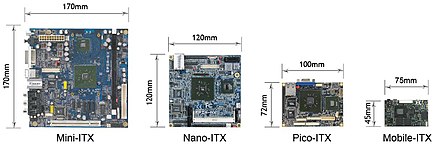Pico-ITX
In computer design, Pico-ITX is a PC motherboard form factor announced by VIA Technologies in January 2007 and demonstrated later the same year at CeBIT. The formfactor was transferred over to SFF-SIG in 2008. The Pico-ITX form factor specifications call for the board to be 10 × 7.2 cm (3.9 × 2.8 in), which is half the area of Nano-ITX.

EPIA PX[edit]
PX10000G[edit]
The first motherboard produced in this form factor is called EPIA PX10000G. It is 10 × 7.2 cm (3.9 × 2.8 in) and 10 layers deep. The operating temperature range is from 0°C to about 50°C. The operating humidity level (relative and non-condensing) can be from 0% to about 95%. It uses a 1 GHz VIA C7-M processor, a VIA VX700 chip set, and is RoHS compliant.
It has onboard VGA video, VIA VT6106S 10/100 8P8C Ethernet, UDMA 33/66/100/133 44-pin ATA (1x), and SATA (1x) I/O. DVI and LVDS video-out, USB 2.0, COM, PS/2 Mouse & Keyboard, and HD 5.1 channel audio (supplied by a VIA VT1708A chip) are supported through the usage of I/O pin headers and add-on modules/daughter cards.[1][2][3]
It has been demonstrated running Microsoft Windows XP and Windows Vista. older versions of major Linux distributions, including Fedora Core 6 and Ubuntu 7.10, will also run on it.[4] It is available as a single board, as well as part of a barebones package, the Artigo, a small form factor complete computer.
PX5000[edit]
This model is similar to the PX10000G, but uses the 500 MHz VIA Eden ULV CPU.
There are two versions of this model, the PX5000G, which has a fan-assisted heatsink, and the PX5000EG, which has a fanless heatsink.
Add-on modules[edit]
(Note: Either the VIA PX-O add-on module or 4 USB 2.0 I/O are supplied in retail packages.) The VIA PX-O daughtercard supplies access to:
- 1 RCA-out for S/PDIF usage
- 4 USB 2.0 ports
- 1 3.5mm Mic-in, 1 3.5mm line-out, 1 3.5mm line-in
- 1 buzzer/speaker
- 1 CN9 connector (function TBC)
- 1 CN10 connector (function TBC).[5]
The VIA VT1625M daughtercard supplies access to:
- 1 external TV-out
- 1 video capture port.[2]
The Serener PXFPIO (also labeled under VIA PX-DIO) is 109mm × 22mm in size and connects via a 120mm ribbon cable through a daughter card. This addon may require modification to the heatsink due to the size of the daughter card. It supplies access to:
The VIA PX-TC daughter card, compatible with the PX10000G only, is designed to enhance the multimedia capture and output. It supplies access to:
EPIA-P700[edit]
The second motherboard series in this form factor, the P700 series improves upon the PX10000G series by offering Gigabit Ethernet (Using the VIA VT6122 chipset) or a 10/100 Ethernet adapter (VIA VT6107) as a manufacturing option, integrating the power adapter (allowing for direct +12V DC-In & enabling it to directly power SATA), and making the Ethernet & VGA ports optional via the P700-A daughter card.
Expanded functionality is offered via the following pin I/O:
- 1 LAN
- 1 VGA/DVI
- 1 COM Port
- 1 Audio pin connector for Line-out, Line-in, MIC-in
- 1 Front panel
- 4 USB 2.0
- 1 PS2 mouse/keyboard
- 1 LVDS
- 1 LPC/SM Bus/GPIO (Unusable due to VIA not releasing a GPIO driver)
The EPIA-P700-10L has a 1 GHz VIA C7 CPU.
The EPIA-P700-05LE has a 500 MHz VIA Eden ULV CPU and has a passive heatsink.
Add-on modules[edit]
The P700 comes retail with the P700-A & P700-B daughter cards.[9]
The P700-A supplies:
- Gigabit Ethernet
- 1 VGA port
- 1 COM port
- DVI port via I/O cable
The P700-B supplies:
Intel-based products[edit]
Even though the form factor was introduced by VIA Technologies, there are also boards available based on Intel processors. Some have the CPU and the chipset directly on the Pico-ITX board.
ARM-based products[edit]
Pico-ITX boards are also available with ARM architecture. In this field DH electronics uses the standardized DHCOM Computer On Modules with several ARM based modules.
Pico-ITXe[edit]
The Pico-ITXe specification adds onto the Pico-ITX form factor by taking the EPIA-P700 and upgrading the chipset to a VX800, doubling the maximum RAM to 2 GB, allowing for 667/533 SO-DIMM RAM, upgrading the GPU to VIA's Chrome9 HC3, and adding support for SUMIT. Another notable addition is the expansion from 10 to 12 layers thickness.
See also[edit]
References[edit]
- ^ "VIA Pico-ITX Whitepaper" (PDF). Archived from the original (PDF) on 2007-04-22. Retrieved 2007-04-21.
- ^ a b VIA EPIA PX Series Homepage
- ^ E-ITX PX10000G Product Page
- ^ ""Via's incredible shrinking mobo line spawns "pico-ITX""". Archived from the original on 2012-09-09.
- ^ mini-itx.com Review: "VIA EPIA PX10000 Pico-ITX Review"
- ^ Serener PXFPIO Product Page
- ^ mini-itx.com VIA PX-DIO Product Section
- ^ PX-TC Product page
- ^ "Difference between A/B daughtercards."
- ^ VIA EPIA-P700 Series Homepage
- ^ ""Pico-ITX board bears twins"". Archived from the original on 2012-07-19.


